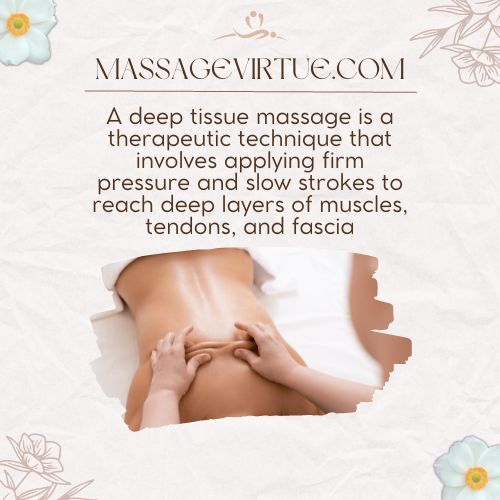If you’ve ever contemplated getting a massage to ease those stubborn muscle knots or simply to unwind, you’ve likely come across the terms “deep tissue” and “shiatsu.”
These two popular massage techniques offer unique experiences and therapeutic benefits.
But what sets them apart?
In this article, we’ll provide a comprehensive comparison of deep tissue massage and shiatsu massage, helping you make an informed choice based on your needs.
Deep Tissue Vs Shiatsu Massage – A Detailed Comparison
Let’s kick things off with a quick side-by-side comparison to give you an at-a-glance understanding of the differences between deep tissue and shiatsu massages:
| Aspect | Deep Tissue Massage | Shiatsu Massage |
| Origin | Western | Japanese (based on TCM) |
| Technique | Firm pressure, targeting deep muscle layers | Gentle pressure, focusing on acupressure points and energy flow |
| Main Goals | Muscle pain relief, myofascial release, improved mobility | Stress relief, relaxation, balancing energy meridians |
| Pressure Level | High | Moderate to low |
| Oil or Clothing | Often uses massage oil; minimal clothing | Performed fully clothed; no oil involved |
| Session Style | Focused on specific problem areas | Holistic approach, balancing the entire body |
| Sensation During | Can be intense and uncomfortable, “good pain” | Generally gentle and soothing |
| Post-Massage Effects | May experience soreness followed by relief | Immediate relaxation, improved energy flow |
| Benefits | Targeted pain relief, muscle recovery | Stress reduction improved overall well-being |
What is a Deep Tissue Massage?
Deep tissue massage is a therapeutic massage technique that focuses on releasing chronic muscle tension and knots.

It’s ideal for those who suffer from muscle soreness, chronic pain, or restricted mobility.
Deep tissue massage involves the therapist using their fingers, knuckles, and elbows to apply deep pressure to specific muscle groups.
This targeted approach helps break down adhesions (bands of painful, rigid tissue) that can form in muscles due to injury or overuse. The pressure applied can sometimes be intense, but it’s precisely what’s needed to release deeply rooted tension.
Deep Tissue Massage Benefits
Deep tissue massage offers various benefits. Let’s explore some of them:
1. Pain Relief
Deep tissue massage is well-known for its skill in easing chronic pain, especially for people dealing with issues like fibromyalgia or aching lower back.
The firm pressure used works wonders in relaxing tight muscles and reducing pain.
2. Improved Mobility
If you’ve been feeling stiff or struggling to move freely, deep tissue massage comes to the rescue.
It breaks down tough knots in your muscles, making you more flexible and able to move without discomfort.
3. Stress Reduction
While it might not give you that instant “ahh” feeling like a Swedish massage, deep tissue still does a great job of relieving stress.
As your muscles unwind, your mind follows suit, leaving you feeling more relaxed.
What is a Shiatsu Massage?
Shiatsu massage, originating in Japan, is deeply rooted in Traditional Chinese Medicine (TCM).
The word “shiatsu” translates to “finger pressure,” which gives you a clue about its primary technique.
Shiatsu massage is a gentle and rhythmic massage that involves applying pressure to specific points along the body’s meridians (energy pathways).
These points, similar to acupressure points, are vital for maintaining the body’s energy flow.
Shiatsu Massage Benefits
Shiatsu is a well-known massage therapy for human health. It offers various benefits. Let’s have a closer look at some of the amazing benefits:
1. Stress Relief
Shiatsu massage is excellent for making stress vanish.
It’s like a gentle, comforting hand guiding away your worries by applying soft pressure to specific body points.
This soothing touch helps calm your nerves, leaving you feeling wonderfully relaxed.
2. Balanced Energy Flow
Traditional Chinese Medicine says blocked energy (qi) leads to trouble. Shiatsu’s job is to unblock it. Think of it as an energy traffic cop, ensuring everything flows smoothly.
This harmony boosts your overall well-being, making you feel better inside and out.
3. Pain Relief
Shiatsu may not be a superhero, but it can still help with pain.
It’s like a soothing balm for tension headaches and minor aches. The gentle pressure works its magic, easing your discomfort and helping you feel more comfortable.
4. Improved Sleep
Trouble sleeping? Shiatsu could be your bedtime buddy. Many people discover that after a session, their sleep is top-notch.
It’s like a lullaby for your body, leaving you waking up feeling super refreshed.
Shiatsu Massage Vs Deep Tissue
To further aid your decision-making process, let’s summarize the potential risks associated with each massage technique:
| Risk | Deep Tissue Massage | Shiatsu Massage |
| Soreness | Likely to experience muscle soreness post-massage | Rarely leads to significant soreness |
| Bruising | May cause bruising, especially with deep pressure | Generally gentle and doesn’t result in bruising |
| Discomfort During Session | Discomfort and “good pain” are common during the massage | Shiatsu is generally soothing with minimal discomfort |
| Rare Risks | Rare risks include injury if not performed correctly | Few risks, but some individuals might feel fatigued or temporarily sore |
Which One is Better for You?
The choice between deep tissue and shiatsu massage ultimately comes down to your specific needs and preferences.
- Choose Deep Tissue If:
- You’re seeking relief from chronic muscle tension or pain.
- You don’t mind some discomfort during the massage if it means long-term relief.
- You prefer a more intense and targeted approach.
- Choose Shiatsu If:
- You’re looking for a gentle, stress-relieving experience.
- You want to improve your overall energy flow and balance.
- You have a low tolerance for intense pressure or soreness during a massage.
Conclusion
In conclusion, whether you opt for the deep, targeted pressure of deep tissue massage or the soothing finger pressure of shiatsu massage, both techniques offer valuable therapeutic benefits.
Your journey to relaxation and relief starts with understanding your needs and choosing the massage that suits you best.
So, go ahead, book that appointment, and embark on a path to a more relaxed and pain-free you!
FAQs
Is Deep Tissue Massage the Same as Shiatsu?
No, deep tissue and Shiatsu massages differ significantly.
Deep tissue employs intense pressure to target muscle tension, while Shiatsu employs gentle pressure on specific points along energy pathways. Their techniques and goals are distinct.
Is Shiatsu Massage Effective?
Indeed, Shiatsu massage proves effective for various purposes. It promotes stress relief, reduces pain by harmonizing energy flow, and enhances overall well-being.
Many find it beneficial for relaxation and minor aches.
What Is a Deep Shiatsu Massage?
There’s no such thing as a “deep Shiatsu” massage. Shiatsu traditionally involves gentle finger pressure, which contrasts with the intense, deep pressure of deep tissue massage.
When Should You Not Do Shiatsu Massage?
Avoid Shiatsu if you have infectious skin conditions, open wounds, fractures, or recent surgeries.
Pregnant women should consult a healthcare professional before undergoing Shiatsu due to potential pressure points affecting pregnancy.
What Are the Disadvantages of Shiatsu?
Disadvantages of Shiatsu can include soreness if excessive pressure is applied.
Additionally, finding a skilled Shiatsu therapist is crucial for an effective session. It may not be suitable for those seeking very deep muscle work or specifically targeted pain relief.


